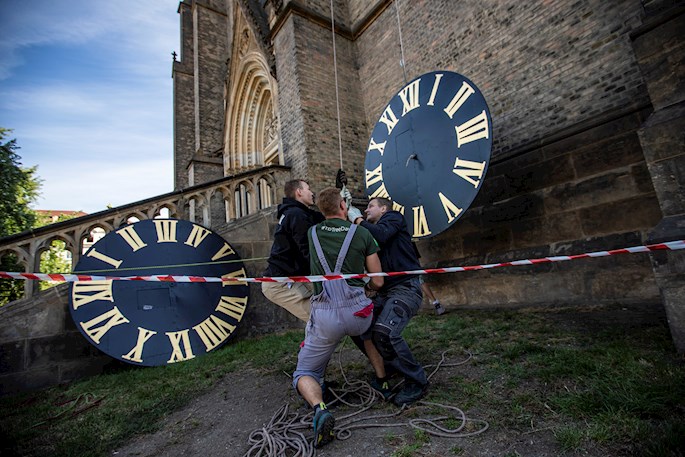Prague woman keeps age-old artisanal clockmaking alive
Published : 10 Dec 2020, 00:46
Classic clocks are part of the landscape of Prague, known as the "city of a hundred towers" for its centuries-old mechanical devices - including the famed Astronomical Clock in the Old Square.
They are part of an artisanal tradition that is kept alive to this day by a former landscaper, Mariana Nesnídalová.
"It was not my dream. I preferred to design gardens, and this developed over time," the 50-year-old Prague native tells Efe.
She runs L. Hainz, a family business that was founded in 1836 which has carved out a niche in the production and manufacture of mechanical tower clocks - for town halls, churches and monuments - that are built using techniques that date back from the second half of the 19th century. The company also repairs and maintains the intricate timepieces.
Nesnídalová started at Hainz as an accountant at the age of 24, after the company - which had been appropriated by the communist regime that ruled the Czech Republic for four decades and which imprisoned her great-grandfather, grandfather and great-uncle - was returned in the 1990s to the heirs of the former incarcerated owners.
A FAMILY TRADITION
After studying watchmaking, she combined administration with work as a laborer, where she discovered the hidden charm of climbing up narrow, dilapidated and dusty staircases, despite the army of resident pigeons occupying the tower.
A decade ago, she took over the reins at Hainz to become just the third woman to head the only remaining company in the Central European country that specializes in large, handcrafted clocks. Nesnídalová is also the sixth generation of a watchmaking dynasty that is closely linked to the history of Prague.
The company employed almost 200 workers before the state confiscated it in 1948. Today, its catalog has been reduced to one kind of product: large mechanical clocks for towers and churches, using a unique technology that is entirely its own. Hainz manufactures less than six units each year. This low output means the endeavor is not the most lucrative.
“None of us make 2,000 euros,” says Nesnídalová, who heads an entirely male team, a situation that she says has not always been easy for her. Although she admits that despite the challenges, she also has many other professional "satisfactions".
"When I climb a tower and there is a clock that my ancestors made 100 or 110 years ago, and it still works, I say to myself: 'We are good'," she says proudly.
One of the biggest challenges is knowing how to innovate in a sector where everything is done by hand using techniques that have not changed since 1890.
"We know how to modernize clocks so that no one has to climb a tower to wind them and so that they are accurate," she says of the technological advances in an industry where a clock’s lifespan is more than a century, far surpassing that of electric timepieces.
THE JEWEL IN THE CROWN
One of the company's leading current projects is the maintenance of Prague’s Astronomical Clock, or "Orloj". Built four centuries before Hainz was founded, the clock is just down the street from the world famous Charles Bridge, the city’s most visited tourist attraction.
The company has been maintaining it for more than 150 years, thanks to an agreement reached by its founder in 1865, when he restored the famous medieval chronometer that was built in 1410: instead of a fee, he took over maintenance of the clock.
Therefore, kickstarting the company after the fall of communism in 1990 was not only a matter of professional interest, it was also a way of keeping a family tradition alive.
A fundamental part of that legacy was taking care of the "Orloj". Every hour, crowds of hundreds of curious onlookers gather to listen to the bell being rung by the figure of Death. Above the clock, 12 apostles appear. The clock also features an astronomical dial with intricate details of the position of the sun and moon and other astronomical details.
Nesnídalová is aware of the “great responsibility” Hainz has in making sure the clock works properly and that day after day, admirers can continue to be “fascinated” by the various elaborate figures, panels and dials.
"This jewel is the most important monument from a technical point of view. We are proud that our family has taken care of it for such a long time", she says.
Her company rebuilt it in 1945, after it was damaged in a fire in 1945 during the Second World War, and has carried out several restorations since. The most recent was in 2018, when the clock's intricacies were restored in their Gothic luster but that keeps 80 percent of its original character.
PASSION AND PRIDE
Over the years, Nesnídalová has developed a real passion for these handmade mechanical time devices, to such an extent that she has curated a beautiful collection in her workshop in Lysa nad Labem, about 40 kilometers from Prague, which includes some highly prized and valued specimens.
"Many are dedicated to collecting bags. I, on the other hand, collect clocks," says Nesnídalová.
Her years at Hainz have truly imbued her with the weight of culture and history that the city’s clocks represent, and her enthusiasm and pride in her work has not waned.
The company, whose manager and four craftsmen look after some 80 clock towers in the Czech capital, was the leading maker of chronometers in Bohemia from the time of the former Austro-Hungarian empire until World War II.
“It is a great responsibility, it is the most important historic sight in terms of technology in our country. And it is an honor. Our family has been taking care of this sight for a long time”, Nesnídalová says.
“It's simply a gem and you need to take care of it”.


